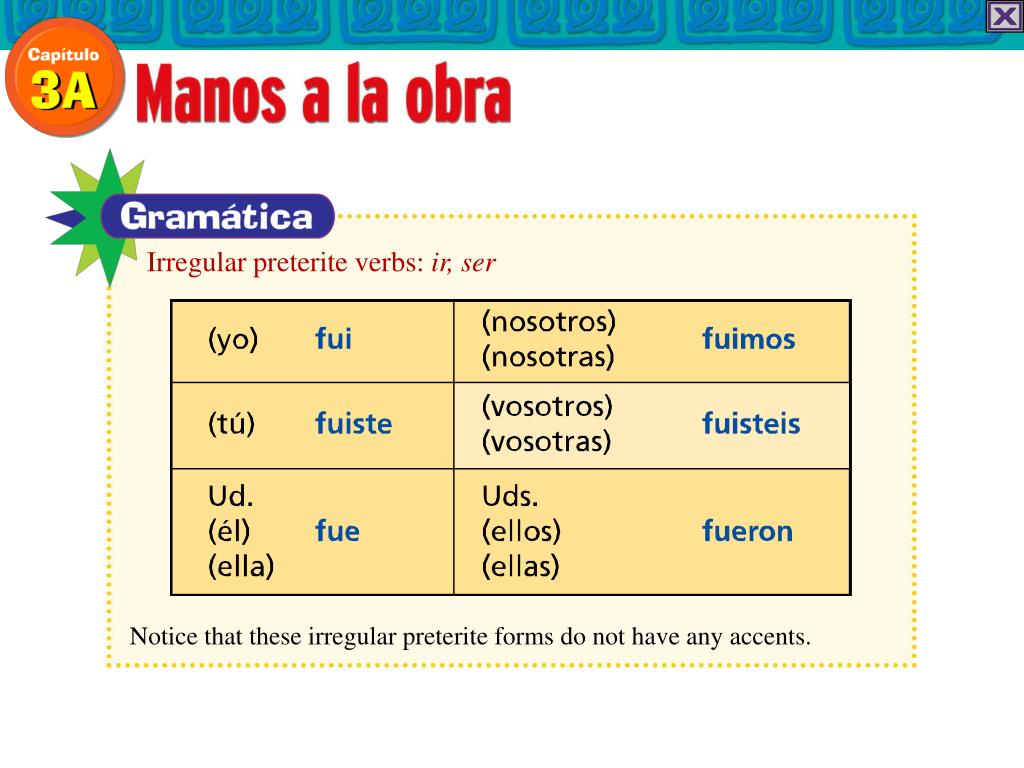
 Sometimes, we have to change the final consonant of certain -ar verbs in the 1 st person singular in order to preserve the pronunciation.Įxample: c becomes qu → atra car moor ( a ship) - atra qué g becomes gu → col gar hang, add - col gué gu becomes gü → averi guar investigate, research - averi güé z becomes c → empe zar begin - empe cé. For verbs ending in a vowel + -er/-ir, we change - i to a - y in the 3 rd person singular and plural form.Įxample: caer fall - caí, caíste, ca yó, caímos, caísteis, ca yeron distribuir distribute - distribuí, distribuiste, distribu yó, distribuimos, distribuisteis, distribu yeron leer read - leí, leíste, le yó, leímos, leísteis, le yeron oír hear - oí, oíste, o yó, oímos, oísteis, o yeron. Preterite verbs: The u group: poder 3.1.14 Irregular Preterite verbs: The. The endings of these verbs are irregular (-e, -iste, -o, -imos, -isteis, -eron).Įxample: traducir translate - trad uje, trad ujiste, trad ujo, trad ujimos, trad ujisteis, trad ujeron Asking and Answering Questions in the Preterite Tense (-AR verbs) Preterite.
Sometimes, we have to change the final consonant of certain -ar verbs in the 1 st person singular in order to preserve the pronunciation.Įxample: c becomes qu → atra car moor ( a ship) - atra qué g becomes gu → col gar hang, add - col gué gu becomes gü → averi guar investigate, research - averi güé z becomes c → empe zar begin - empe cé. For verbs ending in a vowel + -er/-ir, we change - i to a - y in the 3 rd person singular and plural form.Įxample: caer fall - caí, caíste, ca yó, caímos, caísteis, ca yeron distribuir distribute - distribuí, distribuiste, distribu yó, distribuimos, distribuisteis, distribu yeron leer read - leí, leíste, le yó, leímos, leísteis, le yeron oír hear - oí, oíste, o yó, oímos, oísteis, o yeron. Preterite verbs: The u group: poder 3.1.14 Irregular Preterite verbs: The. The endings of these verbs are irregular (-e, -iste, -o, -imos, -isteis, -eron).Įxample: traducir translate - trad uje, trad ujiste, trad ujo, trad ujimos, trad ujisteis, trad ujeron Asking and Answering Questions in the Preterite Tense (-AR verbs) Preterite. 
Verbs that end in - ucir, change - uc to -uj.The following verbs have both irregular endings and irregular stems.

Used to express actions completed in the past. Other Irregular Verbs irregular endings and stems.
Some - ir verbs, change their stem in the 3 rd person singular and plural (-e → -i, -o → -u).Įxample: p edir ask for - pedí, pediste, p idió, pedimos, pedisteis, p idieron d ormir sleep - dormí, dormiste, d urmió, dormimos, dormisteis, d urmieron Conjugation Chart for Preterite (Past Tense) Pretérito (pretérito perfecto simple) Spanish Verbs. The use of these verbs is no different from other verbs in this tense, but they are just radically different. It expresses actions that are completed at the moment being discussed. It can indicate a change in state as well as the start or completion of an action in the past. We know from the context which verb is meant. The preterite tense is mostly used to narrate events in the past. Notice that the forms ‘yo’, ‘él’, ‘ella’, and ‘usted’ omit the accent mark in the preterite endings. The verbs ser and ir are identical in the preterite tense. Poder preterite conjugations are formed with the irregular stem pud. Vine, viniste, vino, vinimos, vinisteis, vinieron Traje, trajiste, trajo, trajimos, trajisteis, trajeron Tuve, tuviste, tuvo, tuvimos, tuvisteis, tuvieron Supe, supiste, supo, supimos, supisteis, supieron Quise, quisiste, quiso, quisimos, quisisteis, quisieron Puse, pusiste, puso, pusimos, pusisteis, pusieron Pude, pudiste, pudo, pudimos, pudisteis, pudieron Hice, hiciste, hizo, hicimos, hicisteis, hicieron Hube, hubiste, hubo, hubimos, hubisteis, hubieron 
In Spanish Preterite Tense, the 3 regular patterns are for verbs ending in ar, er, and ir.Preterite Conjugation ( yo, tú, él, nosotros, vosotros, ellos)Īnduve, anduviste, anduvo, anduvimos, anduvisteis, anduvieronĬupe, cupiste, cupo, cupimos, cupisteis, cupieronĭije, dijiste, dijo, dijimos, dijisteis, dijeronĮstuve, estuviste, estuvo, estuvimos, estuvisteis, estuvieron A verb which does not follow these patterns exactly is called an irregular verb. A common -ar verb that has a stem spelling change in the preterite tense is. Irregular VerbsĪ verb is called a regular verb when its conjugation follows a typical pattern. In addition, the preterite endings for Spanish spelling-changing verbs are still -é, -aste, -ó, -amos, -asteis, -aron. The imperfect tense is rarely irregular and can be easily conjugated from this form, which is the yo, and él/ella conjugation. The present perfect tense is formed by combining the auxiliary verb haber with the participio. hacer: to make, to do ir: to go poder: to be able to poner: to put, to place querer: to want, to love saber: to know ser: to be tener: to have traer: to bring venir: to come ver: to see, to watch The following sections explain the formation of the simple past (preterite) of irregular Spanish verbs. Querer appears on the 100 Most Used Spanish Preterite Tense Verbs Poster as the 14th most used irregular verb.įor the present tense conjugation, go to Querer Conjugation - Present Tense. Querer is conjugated as an irregular verb in the preterite tense. Querer is a Spanish verb meaning to want. JIn this Spanish grammar lesson you will learn about the poder preterite tense conjugation.








 0 kommentar(er)
0 kommentar(er)
